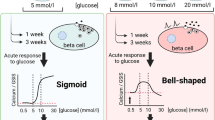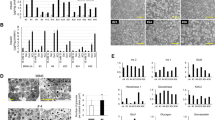Abstract
The complex interaction of nutrient stimuli on the pancreatic B-cell results in the appropriate amount of insulin being secreted to maintain glucose homeostasis. In non-insulin-dependent diabetes mellitus (NIDDM), defects in the regulatory mechanisms of in sulin secretion make a major contribution to the metabolic disorders associated with the disease (Kahn and Porte, 1990). Possible molecular mechanisms underlying pancreatic B-cell dysfunction in NIDDM include site-specific defects in the stimulus-secretion pathway and alterations of B-cell function consequent to changes in external influences on the B-cell (Flatt et al., 1994). Studies in man and experimental animals both in vivo and in vitro have indicated that long-term exposure to a hyperglycaemic environment results in a gradual impairment of insulin secretion (Leahy et al., 1992; McClenaghan et al., 1996; Barnett et al., 1993, 1994). Such observations support the concept of glucose toxicity and the view of hyperglycaemia as an inducer, as well as a consequence of B-cell dysfunction (Unger and Grundy, 1985). Recent studies indicate that there may be species variation in the susceptibility to the detrimental effects of a hyperglycaemic environment (Eizirik and Sandier, 1992; Eizirik et al., 1989). These observations raise two important considerations. Firstly, species differences may reflect differences in endogenous mechanisms which protect against the effects of glucose toxicity. Secondly, the deleterious effects of hyperglycaemia may be manifest in genetically susceptible B-cells where increased functional strain is imposed on existing weakspots in the insulin secretory pathway. In this study we investigated the effects of hyperglycaemia on insulin secretory responsiveness of the novel clonal B-cell line, BRIN-BD11 (Flatt et al., 1993). Possible reversal of the glucose toxic effects by subsequent culture at lower glucose concentrations were also examined.
Access this chapter
Tax calculation will be finalised at checkout
Purchases are for personal use only
Preview
Unable to display preview. Download preview PDF.
Similar content being viewed by others
References
Flatt, P. R. and Bailey, C. J. (1981) Development of glucose intolerance and impaired plasma insulin repsonse to glucose in obese and hyperglycaemic (ob/ob) mice. Horm. Metab. Res. 13:556
Barnett, C. R., Wilson, A. M., McClenaghan, N. H., Yoon, T. W., Swanston-Flatt, S. K., Ah-Sing, E. and Flatt, P. R. (1993). Effects of chronic hyperglycaemia on the function of insulin-secreting cells maintained in tissue culture. Diabetic Medicine Suppl 3, 10: S24
Barnett, C. R., Wilson, A. M., McClenaghan, N. H., Yoon, T. W., Swanston-Flatt, S. K. and Ah-Sing, E. (1994) Impaired insulin secretory responsiveness of BRIN-D11 cells cultured at high glucose concentrations. Diabetic Medicine. 20:164
Eizirik, D. L., Korbutt, G. S. and Hellerström, C. (1992) Prolonged exposure of human pancreatic islets to high glucose concent rations in vitro impairs B-cell function. J. Clin. Invest. 90:1263
Eizirik, D. L. and Sandler, S. (1989) Sustained exposure to toxically damaged mouse pancreatic islets to high glucose does not increase B-cell dysfunction. J. Endocrinology 123:47
Flatt, P. R., Abdelwahab, Y. H. A., Wilson, A. M., Barnett, C. R., O’Harte, F. R. M. and Swanston-Flatt, S. K. (1994) Site-specific defects and glucose toxicity in pancreatic B-cell dysfunction of non-insulin-dependent diabetes mellitus. in: “Frontiers of Insulin Secretion and Pancreatic B-cell Research”. Eds. P. R. Flatt, S. Lenzen, Smith-Gordon & Co. Ltd, London, pp. 481–489
Kahn, S. E. and Porte, D., Jr, (1990) The pathophysiology of type II (non-insulin-dependent) diabetes mellitus: Implications for treatment. In: Ellenberg and Rifkin’s Diabetes Mellitus: Theory and Practice Rifkin, H. and Port, D. Jr, eds., 4th edn., Elsevier, New York
Leahy, J. L., Bonner-Weir, S. and Weir, G. C. (1992) B-cell dysfunction induced by chronic hyperglycaemia; current ideas on mechanism of impaired glucose-induced insulin secretion. Diabetes Care 15:442
McClenaghan, N. H., Barnett, C. R., Ah-Sing, E., Abdel-Wahab, Y. H. A., O’Harte, F. P. M., Yoon, T.-W., Swanston-Flatt, S. K., and Flatt, P. R. (1996) Characterization of a novel glucose-responsive insulin-secreting pancreatic B-cell line, BRIN-BDII, produced by electrofusion. Diabetes 45:1132–1140
Rossetti, L., Giaccari, A. and DeFonzo, R. A. (1990) Glucose toxicity. Diabetes Care 13:610
Unger, R. H. and Grundy, S. (1985) Hyperglycaemia as an inducer as well as a consequence of impaired islet cell function and in sulin resistance: implications for the management of diabetes. Diabetologia 28:119
Yki-Järvinen, H. (1992) Glucose toxicity. Endocrine Reviews 13:415
Author information
Authors and Affiliations
Editor information
Editors and Affiliations
Rights and permissions
Copyright information
© 1997 Springer Science+Business Media New York
About this chapter
Cite this chapter
Wilson, A.M., Barnett, C.R., Flatt, P.R. (1997). Altered Secretory Responsiveness of Brin-BD11 Cells Cultured under Hyperglycaemic Conditions is not Readily Reversed by Subsequent Culture in Lower Glucose Concentrations. In: Soria, B. (eds) Physiology and Pathophysiology of the Islets of Langerhans. Advances in Experimental Medicine and Biology, vol 426. Springer, Boston, MA. https://doi.org/10.1007/978-1-4899-1819-2_50
Download citation
DOI: https://doi.org/10.1007/978-1-4899-1819-2_50
Publisher Name: Springer, Boston, MA
Print ISBN: 978-1-4899-1821-5
Online ISBN: 978-1-4899-1819-2
eBook Packages: Springer Book Archive




